This article is part of a partnership between Spoon IU and Food & Wine magazine to increase awareness about the problem of food waste on our campus. Food & Wine’s microgrant of $35 funded a cooking demonstration featuring expired foods, which served a 6-course meal to 20 people.
We love to talk about food, but now’s the time to shift our conversation away from the table and towards the garbage.
Food waste is one of the most unbelievably frustrating global crises because time, money, labor and one-third of all food produced each year is wasted for no reason. Consumers play a major role in this issue when they mistakenly throw out food that’s past its expiration date, despite that fact that expiration date labels are unregulated and completely irrelevant to food safety.
In an effort to disprove labeling misconceptions and encourage university students to cook with food they might normally throw out, we at Indiana University’s chapter of Spoon recently hosted a cooking demonstration featuring expired foods. We’ve compiled some helpful tips for when you’re at the store, at home, and in your community so that you can reduce food waste wherever you are.
In the store:
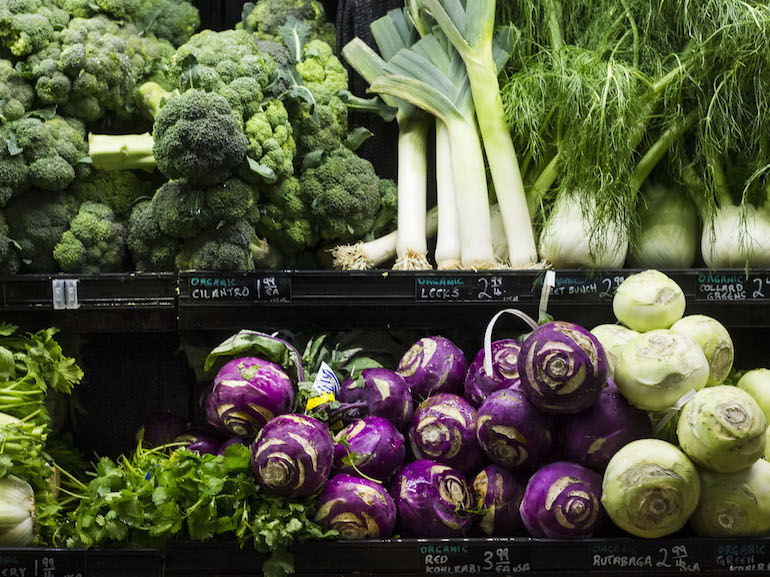
Photo by Natsuko Mazany
Whether you’re on a mission to complete your shopping list in record time or you’re just meandering through the produce aisles, you’ve probably decided not to buy something based on its too-close-for-comfort expiration date at least once.
Despite your best intentions of following food safety guidelines, date labels such as “sell by”, “use by” and “best by” are not regulated by the government and are actually just suggestions from food manufacturers to mark when the quality (rather than safety) of the product will likely decline.
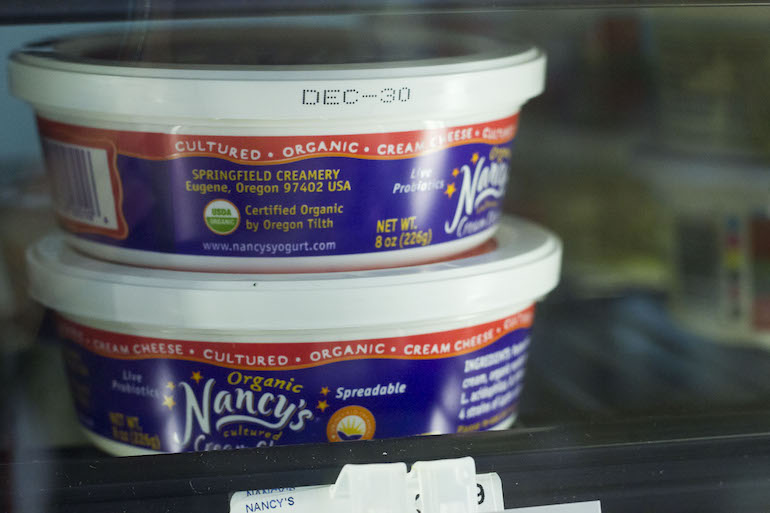
Photo by Natsuko Mazany
Confusion over the meaning of these labels is a major problem for stores because customers are unwilling to buy products that are approaching those arbitrary expiration dates. This inability to sell causes grocery stores to throw out about $2,300 worth of out-of-date food every day. It doesn’t have to be like this. France recently made it illegal for supermarkets to throw away edible food through legislation that makes stores donate would-be food waste to charity.

Photo by Natsuko Mazany
The first step in preparing for our cooking demonstration at IU was to source food that we could work with. Thanks to a donation of culled groceries from Bloomingfoods we had a variety of options for our recipes and more importantly we had a striking starting point for a discussion on in-store waste.
Groceries that are “culled” are items that cannot be sold because they are either past their expiration date or because they are not aesthetically pleasing enough for the average consumer. Of the donated food items only two were expired: tofu (2 days past the date) and Greek yogurt (10 days past the date).
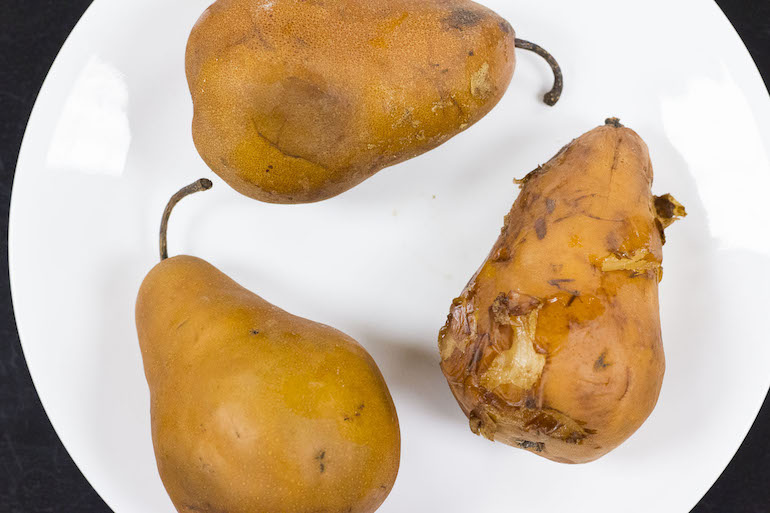
Photo by Natsuko Mazany
All three of these pears were on their way to the dumpster. Yes, there is visible scaring and torn skin on one of them, but all it needs is a little TLC and you’d still get sweet pear slices. Due to imperfections in its appearance the culled produce couldn’t be sold, so we inherited a scrappy cucumber, some dinged pears, nonuniform raspberries and some tomatoes as potential recipe ingredients.
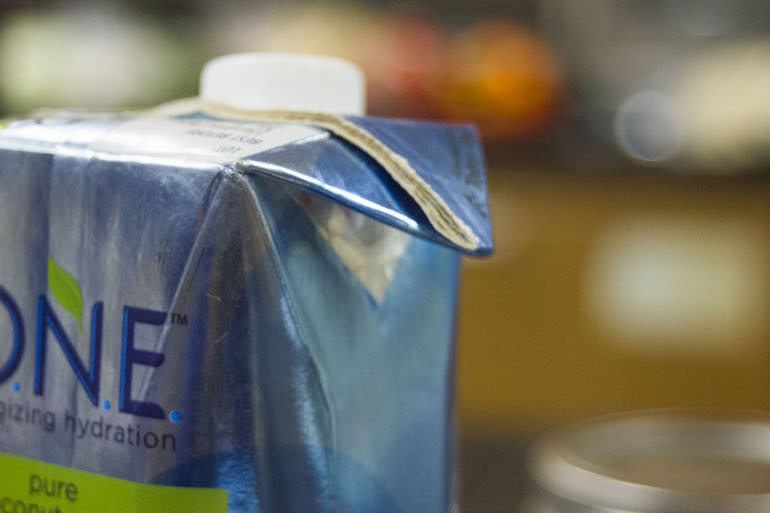
Photo by Natsuko Mazany
It turns out that the condition of a product’s packaging also has an effect on its ability to be sold. This container of coconut water was unsellable because the corner of the packaging had flipped up, even though the container itself was not punctured or faulty in any way. That means that this perfectly unscathed, unopened, and unexpired bottle of coconut water would’ve been thrown out with the garbage if we hadn’t saved it for our cooking demonstration.
In your home:

Photo by Helen Poon
Confusion about labeled dates, anxiety over food safety and cooking inflexibility causes nine out of ten Americans to needlessly throw out food.
“Imagine walking out of a grocery store with three bags of groceries, dropping one and not bothering to pick it up,” says Dana Gunders of the Natural Resources Defense Council in the compelling documentary Just Eat It. This excessive purchasing and trashing of food is costing the average American family between $1,350 to $2,275 per year.
In the pursuit of safe eating habits it might seem easier to just follow the expiration date, but the best line of defense is even simpler than that: your senses. Archeological evidence suggests that humans have been cooking for 1.9 million years. Over that time our senses have evolved to warn us when food is dangerous to eat. (That’s why rotten things smell bad – it’s your body’s way of telling you to steer clear of it!)
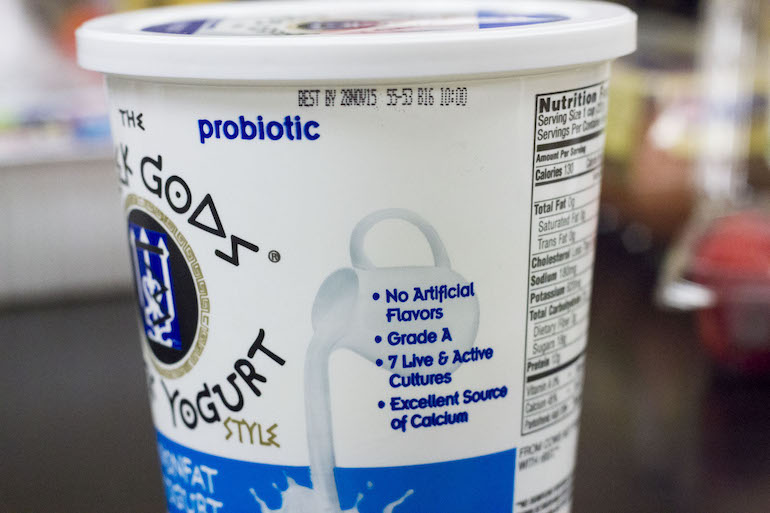
Photo by Natsuko Mazany
Instead of relying on expiration dates, well-meaning safety-conscious consumers should familiarize themselves with information about how long certain foods last.
For the cooking demonstration at IU we confirmed the safety of the expired tofu and Greek yogurt simply by examining the packaging.
If the tofu or yogurt was actually dangerous to eat, the plastic container would be rounded and the whole package would appear bloated because of built up gas. A telltale sign of expiration is if you hear a fizzing sound when you open the lid. (None of these signs were present with our products so we were good to go.)
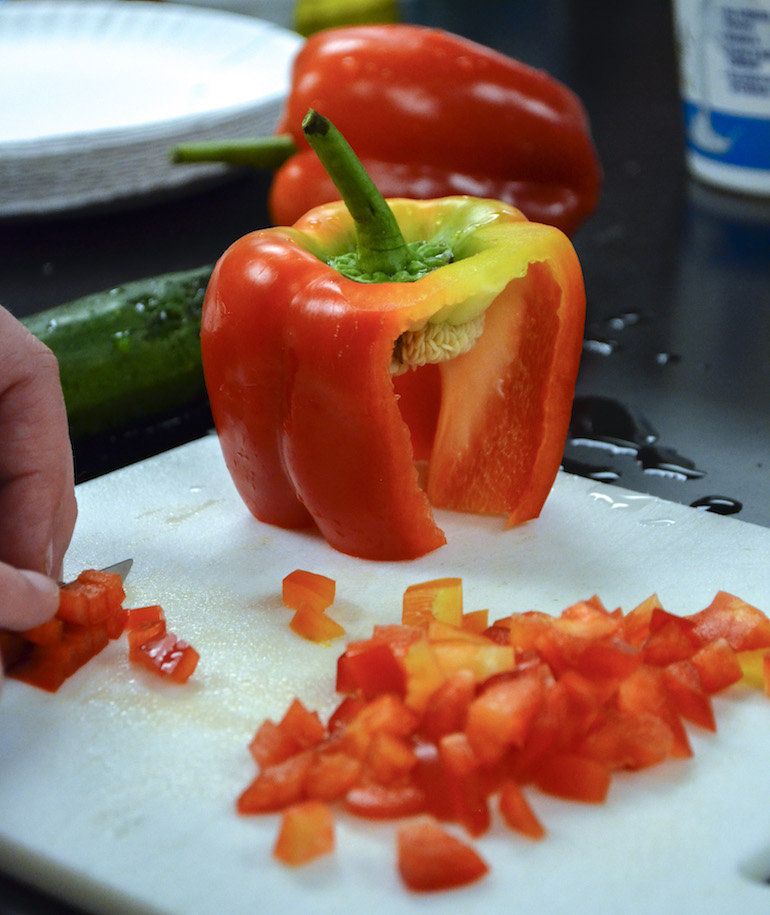
Photo by Grace Hwang
Most of the time the “grossness” of food forgotten in the back of your fridge is only skin deep. A student reluctantly brought a moldy cauliflower and what can only be described as a down-trodden zucchini to the cooking demonstration even though she was skeptical they could be salvaged. But with the magic of a paring knife we were able to take away the bad bits and eat the rest.
Once you know the basics you can get creative in the kitchen and start to rethink your cooking habits. Tricks for using up your stale cereal and turning vegetable scraps into healthy and delicious meals are some examples of the numerous kitchen hacks out there.
#SpoonTip: Waste-Free Kitchen Handbook by Dana Gunders is a great place to start if you are aiming for a more sustainable kitchen.
In your community:

Photo by Natsuko Mazany
Community events are great ways to raise awareness since food naturally brings people together. IU’s food waste cooking demonstration was led by Professor Sara Minard, who teaches geography of food and global food systems among other courses at the university.
Our Indiana University event was inspired by public cooking demonstrations in Denmark, which along with other community-based initiatives have helped reduce Danish food waste by 25% in the past five years.
Since the goal of the cooking demo was to show students how to improvise in the kitchen and work with the food they have, the recipes were only finalized a few hours before the event, when the chef heard what we got from culled grocery donations and participants’ fridges.
Out of the motley crew of ingredients assembled, we created six different delicious dishes: fruit smoothie, labneh cheese dip, cucumber salad, vegetable frittata, tofu scramble, and peanut butter and banana jam dessert toast. (If you’d like to learn more about the dishes we made, check out our recipe recap of the event.)
Fruit Smoothie
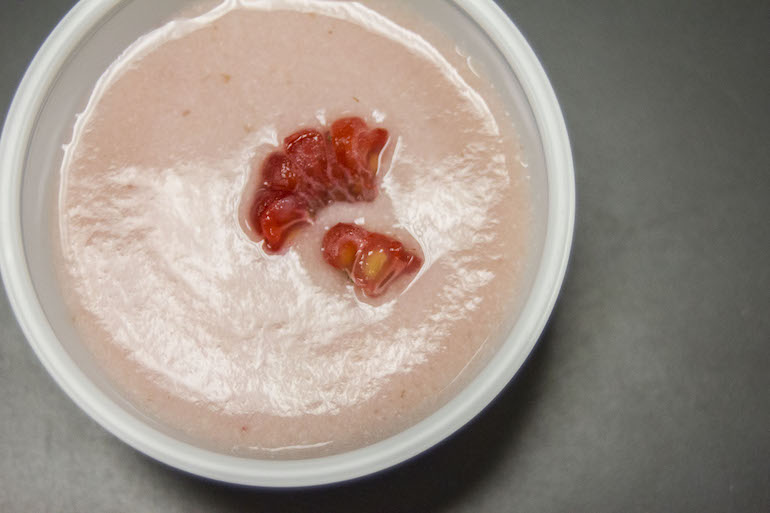
Photo by Natsuko Mazany
(Expired tofu and Greek yogurt, past prime raspberries, pears, coconut water)
Labneh Dip

Photo by Natsuko Mazany
(Expired Greek yogurt, purchased olive oil, oregano)
Cucumber Salad
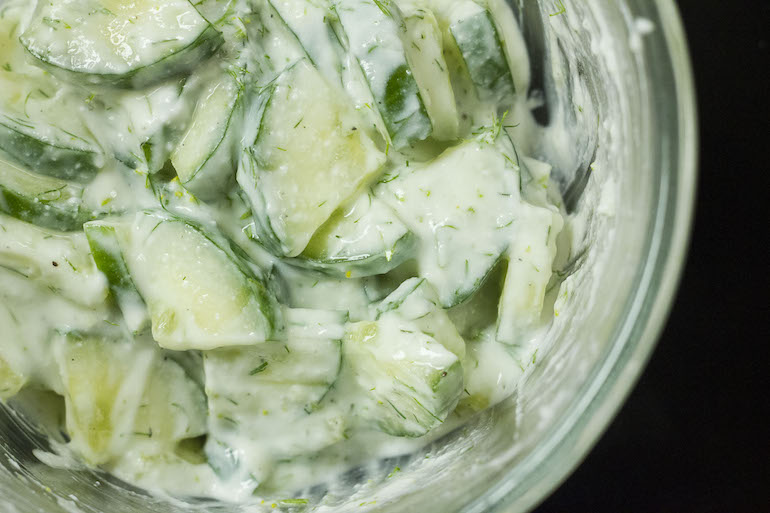
Photo by Natsuko Mazany
(Expired Greek yogurt, past prime cucumber, dill, purchased garlic, salt, pepper)
Vegetable Frittata

Photo by Natsuko Mazany
(Expired pimento cheese, salsa, past prime peppers, zucchini, stale tortilla chips, tomatoes, cauliflower, cilantro stems, purchased eggs, onions)
Tofu Scramble

Photo by Natsuko Mazany
(Expired tofu, salsa, past prime peppers, zucchini, tomatoes, cauliflower, cilantro stems, purchased cumin, coriander, salt)
Banana Jam and Peanut Butter Toast

Photo by Natsuko Mazany
(Expired bananas, purchased bread, peanut butter)
Cooking demos and dinner parties with friends featuring “expired” foods are great ways to educate and inspire the people around you to “re-skill” their kitchen habits. We learned that for the most part the problem areas in produce are only skin deep and don’t affect the flavor or nutritional quality of the food. Cooking is all about the emphasizing and balancing flavors, and usually the dish you’re making doesn’t actually require that the ingredients look perfect.
Make a change:
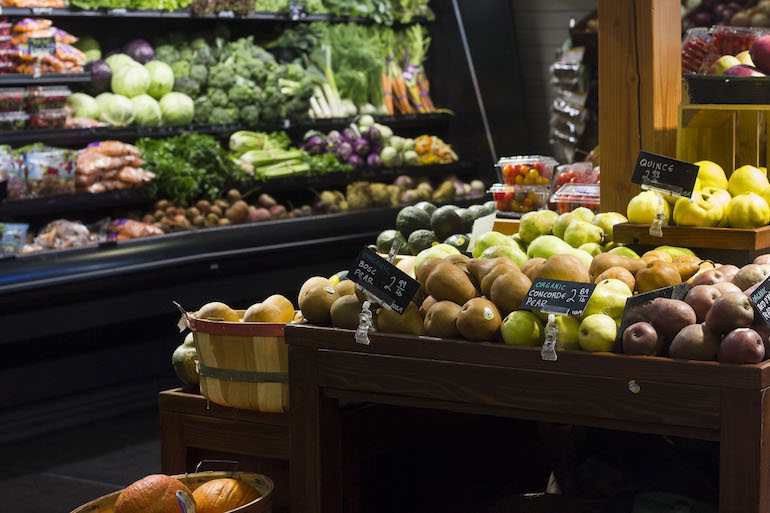
Photo by Natsuko Mazany
Personal changes and community movements are essential in bringing about legislative change in the United States. Exciting change is the air because Congresswoman Chellie Pingree of Maine just introduced the Food Recovery Act to Congress on December 7, 2015. Among the bill’s various provisions is a proposed standardization of food dates. You can read about the specifics of the bill here and learn the most effective ways to contact your state’s congressperson here.
Learning the truth about labels can help disprove expiration date misconceptions and encourage others to eat food instead of throwing it away. By honing your shopping and cooking skills you can be an agent of change from the bottom-up.


